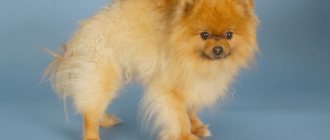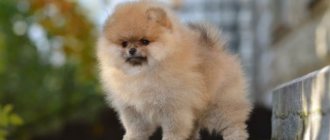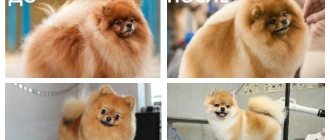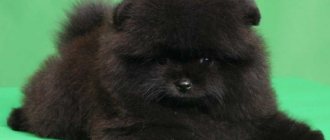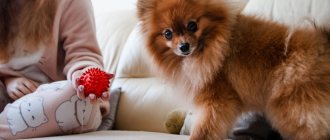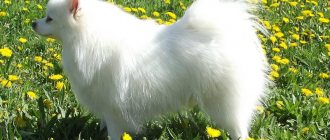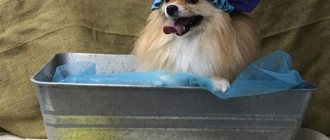Alopecia in Spitz dogs begins in stages, the main signs are:
- At first, the coat becomes dry, looks dead and dull. It doesn't itch.
- The condition of the undercoat is withered and faded.
- At the same time, hair comes out in some places: bald spots form on the croup, neck, hips and stomach, and the tail peels off.
- The guard hairs fall out first. Over time, the downy covering also falls out.
- Thus, the entire body may become bald. At the same time, the head area, hair around the eyes and paws are not affected.
- The skin changes color and becomes dark. Every now and then it peels off and is prone to the appearance of small ulcers. In the abdominal area, the skin atrophies, becomes thin, inelastic, and comedones appear.
An example of what alopecia looks like in a Spitz is shown in the image below.
In fact, the bald Spitz feels satisfactory, there are no deviations in his health. Bare areas are scary only because they can become infected and cause inflammation.
Circumstances of baldness in Spitz dogs
Pomeranians generally have a long, luxurious outer coat and a fairly thick undercoat. When deciding on the choice of a small puppy, potential owners give priority to the most attractive one, but are not always equally aware that they will need to take care of the fur. Failure to prevent the formation of tangles on the fur coat in a timely manner will put the animal's coat at risk. You need to know that hair falling out does not indicate serious problems. Most likely, the pet is simply molting, which affects its “hairiness.”
The reason for the loss of hairiness may lie in poor nutrition, allergies to food and tasty dishes, or hormonal disorders. Under such circumstances, noticeable baldness may occur. When hair problems appear in infancy, there is most likely a congenital pathology, which is rarely observed in Spitz puppies.
Presence of parasites
All kinds of worms that have found refuge in the dog’s gastrointestinal tract are a source of dangerous substances that provoke chronic poisoning in the pet. In addition, uninvited visitors absorb useful elements, causing their shortage in the Spitz’s body.
Mites or fungal microorganisms that live on the outer cover of the animal’s body usually cause a feeling of itching, which leads to the appearance of wounds and scratching. The fur falls out. Bald spots may form, in some cases covered with crust or scales.
Poor diet
Most often, an incorrect approach to diet causes baldness in Pomeranians. Therefore, when feeding your pet, it is best to give preference to natural products or premium food.
To avoid disruption of the functions of the pancreas, when eating natural products, you should not give your dog fatty meats, baked goods, sweets, smoked meats and other harmful products. According to the rules of care, the diet must include a set of nutrients and minerals.
Improper care
The Pomeranian requires conscientious daily care for its coat. It is recommended to comb it daily, or at least several times a week. Effective combing must be done to the full depth, reaching the base of the undercoat, so that the hair follicles also receive their share of massaging actions. Carrying out this procedure stimulates fur development.
The number of times you need to bathe your orange is directly dependent on how dirty it is. As a rule, this is done two or three times throughout the month. The hygienic procedure should be carried out only with the use of detergents specifically designed for the animal.
Note! It is not recommended to wash Spitz dogs with products intended for human hair, since the skin of humans and dogs has different pH levels. This factor is a kind of protection against negative environmental influences.
Rare walks
Pomeranians require daily walks outside. Walking for half an hour should be done twice a day. Since their absence can adversely affect the quality of the pet’s coat.
During the winter months, there is no need to dress up the animal; the thick undercoat, therefore, perfectly protects it from negative temperatures. In turn, the natural environment has a beneficial effect on the growth and condition of the dog’s hair.
Infections
The most common reasons for seeking help from a veterinarian are all kinds of parasitic and fungal infections of the skin of an animal, regardless of age. Any dog can get dermatitis, regardless of its environment.
It is not difficult to cure fungal diseases using the latest popular drugs. The most important thing is not to forget that the sooner the diagnosis is made when visiting a doctor, the easier and faster the path to recovery will be.
Hair loss due to trimming
There are circumstances when alopecia occurs as a result of trimming Spitz dogs with clippers. This happens because the hair is cut to the very ends. Therefore, a large number of shoots are formed, from which the dog is not able to get rid of for a long period.
Very often, pets go bald regardless of the course of molting or do not stop after it. These phenomena lead to global hair loss of the dog, darkening of bare areas of the body. The root causes of the formation of such signs are little known, so treatment becomes very complicated. If an animal begins to dynamically go bald during the molting period or at an atypical time, it is necessary to immediately contact a specialist.
Allergy
The skin of the Pomeranian Spitz is often subject to rashes. The picture is similar to the human reaction to food, medicine, hygiene products and much more. It is important to pay attention to the symptoms in time and identify the allergen. If the pet begins to scratch constantly in the same place and at the same time thinning of the fur begins, examine the guard hairs and undercoat. If the skin turns red or develops a rash or small blisters, this is likely an allergic reaction. Therapy includes a number of basic steps - removing allergens from the pet's diet, using antihistamines and covering the rash with ointments. The treatment method is prescribed by a veterinary specialist, and your function is to follow the recommendations. The dog's complete refusal to take the allergen helps prevent new rashes.
Useful video
A short video about baldness (alopecia) of a Spitz:
-Tags
-Categories
- Dog equipment and accessories (3)
- Our smaller brothers (14)
- Rules for the transportation of animals (6)
- Harmful Customer (10)
- Dog shows (6)
- Dog genetics (12)
- Dogtraining (5)
- Dog training (12)
- Other dog breeds (7)
- Here you can choose a puppy and a young dog (0)
- Dog health (66)
- Angry Vet (4)
- Evil Breeder (45)
- Dog dental system (8)
- Internet to help (18)
- Calendar (5)
- Feeding dogs natural food (21)
- Feeding dogs dry food (15)
- Dog behavior correction (40)
- MAEBY FAY nursery graduates (217)
- Our VICTORIES and awards (14)
- Features of dog behavior (42)
- Breeding dogs (31)
- Before you buy a dog (71)
- Stories about dogs (4)
- Child and dog (9)
- Celebrity dogs (6)
- Breed standard (9)
- Grooming (21)
- Hobbies (150)
- Chihuahua from MAEBY FAY kennel (18)
- Spitz dogs from MAEBY FAY nursery (20)
-Search by diary
Black skin disease (Alopecia X) in Spitz dogs
This type of disease is characterized by total baldness of the pet, in which hair remains only in the head and limbs. This is typical for young Pomeranian Spitz dogs that for some reason did not shed in due time, or for mature pets aged three years and older. The incipient development of the problem can be caused by cutting the dog's hair too short.
Clinical signs
The first symptoms of alopecia in Spitz dogs are the presence of dry skin and brittle hair. It looks like the pet got a bad haircut. After this, profuse loss of hair and fluff continues, and baldness appears. After detecting such symptoms, you should immediately consult a doctor and eradicate serious illnesses.
Method of therapy
It is best to treat alopecia X after consulting a veterinarian and performing the necessary laboratory tests. It has been established that a routine urine test can establish the situation. The first steps of recovery can be taken with the use of special shampoos that will stop skin defects developing in your pet against the background of a weakened immune system. To maintain the functioning of the digestive tract, a combination of vitamins and biological products will be very useful. When the disease is caused by dysfunction of the thyroid gland, treatment is based on hormonal drugs. From time to time, experts recommend castration.
Going to the vet
If your Spitz's hair is falling out, you should seek help from a dermatologist. This is indicated by the following characteristic features:
- Since the age of one year there has been no timely shedding, and the puppy fluff has still not come out.
- Appearance and coat indicate complications.
- Itching and baldness, sores and scratches appear on the body.
- The eyes turn red and the fur around them thins.
- At the site of bald spots, the skin becomes dark.
Thus, if the dog begins to go bald, the first step is to take a general urine and blood test. The results obtained will indicate the true state of affairs.
Diagnostics
The hairless Pomeranian Spitz is a rather sad sight. Despite the fact that the pet does not suffer from discomfort, you should not turn a blind eye to such manifestations.
You need to understand that falling fur is a sign of various diseases. In this case, the pet may or, conversely, may not have additional symptoms. Unfortunately, alopecia today is not diagnosed with a 100% guarantee.
In this case, the doctor first evaluates what the hairless Spitz looks like, and then he has to rule out all the diseases one by one in order to try to determine the one that caused the unpleasant symptoms.
As a rule, the veterinarian will first check whether the pet has hypothyroidism, Cushing's disease, functional tumors in the gonads, functional adrenal cancer, infectious pathologies or dysplasia.
Each of these pathologies requires separate diagnostic measures, so you will have to be patient and wait for the results.
Molting process
Pomeranians, like other purebred dogs, are prone to seasonal shedding. During this process, dead tissue is replaced with new ones - the hair falls out, while making room for fresh hair. The processes of hair loss in Pomeranians are long and intense. During this time, the pet is capable of losing about half the size of its fur coat. There are a number of subtypes of molting: seasonal, age-related and hormonal.
Shedding is seasonal
Under the influence of hormones released in the pituitary gland in response to changing weather conditions, hairs begin to fall out. This occurs between the seasons - in the spring and autumn months. Before the onset of the warm season, Spitz sheds their soft down, and by autumn they free themselves from long hair so that there is free space for a warm fur coat. It has been noted that in dogs that rarely go outdoors, shedding occurs smoothly throughout the year.
Shedding age
When Pomeranian puppies reach four months of age, their first molt occurs. The soft pile of the fluff changes to coarse wool, and it is quite possible that the color of the pet will change. First, the fuzz on the dog’s face disappears, then on the body, and finally the surface of the collar and panties of the hind limbs becomes clear. At the same time, the process proceeds slowly or rapidly.
Under conditions of rapid molting, especially if the animal grows up quickly, the fluff is removed suddenly and the new appearance can shock the owners. This period of coat change occurs when the pet is one year old, and may turn out to be a gradual continuation of the puppy’s molting. Only the sprouted undercoat can fall off within three months, leaving room for coarse hair to grow. The dog acquires the usual appearance of a classic orange at the age of two.
Shedding is hormonal
Female Pomeranians have a tendency to experience excessive hair loss during estrus. In the situation of giving birth to offspring, the female may develop noticeable bald patches, or almost complete hair loss. In the meantime, it is important to provide the dog with a balanced diet and monitor the full range of beneficial elements in the diet.
Hair loss can be caused by hormonal imbalance. It is advisable to highlight the signs of real problems:
- The appearance of bald patches around the dog’s genitals indicates an excess of physiologically active steroids in the body.
- In rare cases, a sterilized female can boast a healthy coat; a deficiency of female sex hormones makes the hair weak and inhibits its growth.
- Excessive, sudden hair loss can be caused by excess cortisol.
- In cases of dysfunction of the endocrine system, the hair becomes thin and comes out in the chest area and on the back of the pet.
Experienced dog lovers know the details of the daily maintenance of Spitz fur. An experienced breeder is able to preserve the shine of the fur even at the moment of rapid molting.
Symptoms
A symptom of BSD is the retention of guard hairs in the hair follicle, which prevents new fur from growing, disrupting the normal shedding process. Due to the fact that this does not happen overnight, the dog adapts to the loss of fur, remains cheerful, playful and feels great.
With this disease, the skin becomes dry, begins to peel, and is easily susceptible to various types of infections and sunburn. The areas with the greatest friction, the sides and thighs, are most susceptible to alopecia; baldness gradually spreads to the tail and neck. At the same time, the head and paws remain covered with thick fur.
Additional Information . Alopecia can be passed on to offspring from parents at the genetic level. Moreover, in one litter there may be healthy puppies, or they may have poor heredity. No breeder will take responsibility for the skin of a Spitz puppy in the future.
Treatment of alopecia in Pomeranians
Treatment of alopecia in Spitz dogs is not easy, because the circumstances of its occurrence have not been studied. And yet, veterinarians have an appropriate treatment method in use.
When black skin disease is diagnosed, several treatment options are available:
- Regular visits to a specialist.
- Castration procedure.
- Take melatonin.
- Use Trilostane.
- Use a mesoscooter.
Castration procedure
The main thing that doctors prescribe when determining X alopecia, when the animal has not been castrated, is removal of the testicles. Most experts compare these difficulties with the presence of disorders in the balance of estrogens and androgens. In half of the episodes, therapy leads to a positive outcome. Due to the fact that the number of healed animals is too small, doctors advise to perform castration using a chemical method. The animal is given an injection of the drug Suprelorin. Its effect lasts up to one year.
Treatment with hormones
If X alopecia begins in a Pomeranian who has undergone a sterilization procedure or no result is obtained after castration, then it is generally recommended to take melatonin. This method of therapeutic influence with drugs is one of the safest. However, the course of treatment is long, lasting up to 3 months.
The pet is prescribed one tablet three times a day. If the dynamics of treatment are positive, the drug is given twice a day. The pet is under observation. If there is no deterioration, switch to the regimen of one tablet per day. Dosage and number of doses are individual and prescribed by a specialist.
It has been noticed that the beginning of recovery occurs within a month and a half from the start of the Spitz taking anti-alopecia medications. Dogs with diabetes should not take melatonin. One of the side effects is the dog's drowsy state.
Mesoscooters
It has been noticed that new hair growth may develop in the affected areas of bald skin. This is confirmed by doctors after taking biopsy tests. There is reason to believe that minor mechanical damage to the skin stimulates the resumption of hair growth. For this purpose, a tool is used, which is a drum with special very thin needles. The mechanism is called a mesoscooter or dermaroller. Under the action of the drum, many small punctures are formed on the skin. This procedure starts the recovery phase.
Owner reviews
Violetta: “I never wanted to cut my dog’s hair short, because, in my opinion, such hair is unpleasant to the touch. We once had our ponytail cut short, and at the slightest tactile contact it was noticeable that the smoothness that, say, was on the back had disappeared.”
Sasha: “The most amazing thing is that after combing a huge mountain of fur, my dog only becomes fluffier. And even easier. The groomer said that you shouldn't put a harness on a Pomeranian because it creates more tangles in the armpits. But I think it’s better to have tangles than to torment my baby with a collar or a noose.”
When is temporary baldness considered normal?
Often, owners don't know what to do when their puppy's hair begins to fall out. There is nothing surprising. This happens to all puppies at the age of three months. At this stage, a physiological change occurs from infant fluff to mature coarse wool. The little ones look like strange, half-bald animals with an elongated face and protruding ears.
Upon reaching a year, the undercoat begins to fall out again. Further coat changes will no longer be so abundant. The final renewal of the hairline occurs at one and a half years.
A completely bald puppy is a clear cause for concern. Hair loss is most likely associated with an unhealthy diet, possible allergies, and a malfunction of the thyroid gland. Only a veterinarian can determine the source of origin.
The presence of physiologically active substances – steroids – in the animal’s body has a negative effect on hair growth or its unexpected loss. The disappearance of hair in the area of the sternum and on the back provokes a malfunction of the endocrine system.
Special coat care
The Pomeranian's coat requires constant care. The bathing procedure is carried out as needed if the dog is very dirty in the mud. There is no strict regime for implementing hygiene procedures. At all other times, it is recommended to treat the dog with dry shampoo aerosols, doing this evenly over the entire surface of the dog.
Young puppies, during the initial molting process, can be cut very short, leaving downy hair.
During the change of coat, the baby should not be washed; the lower tier of hair may become tangled, which will be impossible to comb.
Dog Grooming Tool Kit:
- ordinary massage comb;
- slicker slicker (exclusively during the molting process);
- comb with fine teeth;
- ordinary scissors with rounded cutting ends;
- special dog shampoo and conditioner.
It is recommended to train puppies to hygienic procedures from a young age by lightly scratching them and gently stroking their backs with a massage comb. Over time, the pet will get used to these manipulations, will be submissive, and will begin to beg for a massage.
Sometimes the undercoat falls into clumps; as a rule, this occurs in the armpits, behind the ears, and in the neck area. It is recommended to remove them carefully, trying not to cause pain to the Pomeranian. At worst, the shreds will have to be cut out, which is unacceptable for an exhibition group of specimens. The appearance after cutting is completed takes on a strange appearance.
You can get a table for grooming, then the puppy will adapt faster and will be happy to be brushed.
Combing your pet's fur is necessary until it begins to separate into partings. It is advisable to comb the panties and withers with special care; in these areas the hair is longest and the hair is too thick. Combing is recommended to be done at least once a week, and is allowed frequently during the shedding period.
It is allowed to make a contour trimming of the hair and remove stray strands that differ in length.
Drying
After bathing, Spitz dogs need to be dried. A puppy or adult dog is dried using a special hair dryer. During drying, the air flow should not be hot, otherwise the dog may get burned. First you need to dry your limbs well, and after that we move on to the sides and back. When drying your mane, you should use a comb. With its help, wool dries very well. After drying, cotton swabs should be removed from the animal's ears. Now you can comb your pet, giving its fur the desired volume.
Measures to prevent baldness in Pomeranians
The moment you see that your dog has begun to rapidly go bald, first of all change your diet and review your pet’s coat care system. Most often, this is the reason. For a month, bathe your dog once every three days with Nizoral if there are infectious lesions.
At the same time, it is necessary to deworm the dog, and to prevent the medicine from causing itchy skin, use antihistamines. At this time, the dog is prescribed an additional vitamin complex, and the coat is combed out every day.
Do not forget that excessive relaxation under such circumstances is unacceptable. If you notice signs of baldness on your Spitz's body, immediately take him to the doctor and undergo a comprehensive medical examination. Baldness can be cured, but it is important to provide adequate care for your pet.
Temperament
The most important thing for a Spitz is its cheerfulness. He is always ready for any adventure, is happy to go for a walk and will support his owner in everything. The cheerful disposition and devotion make dogs of this breed the most preferable for friendship and protection.
Loud barking will notify you of the arrival of guests, and the joy from spending time together will be immeasurable.
A properly styled haircut looks elegant
